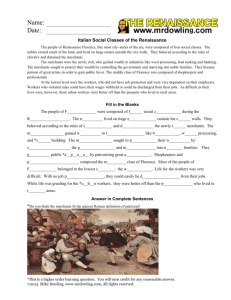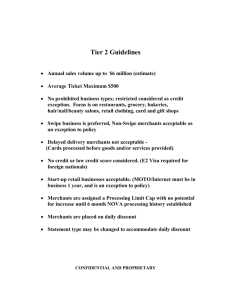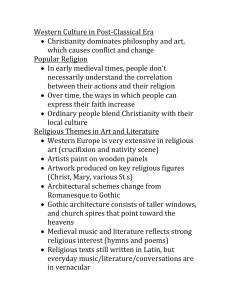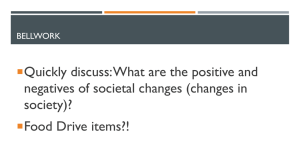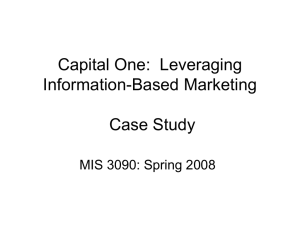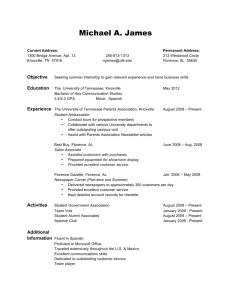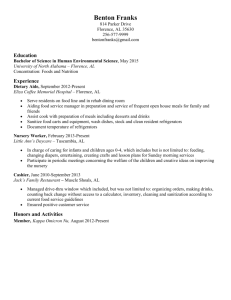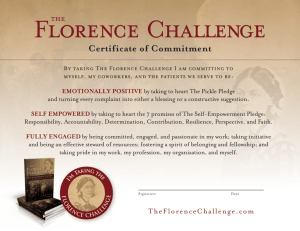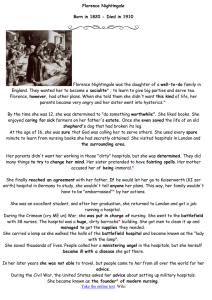The Price for Risk-Taking: Marine Insurance and G C
advertisement
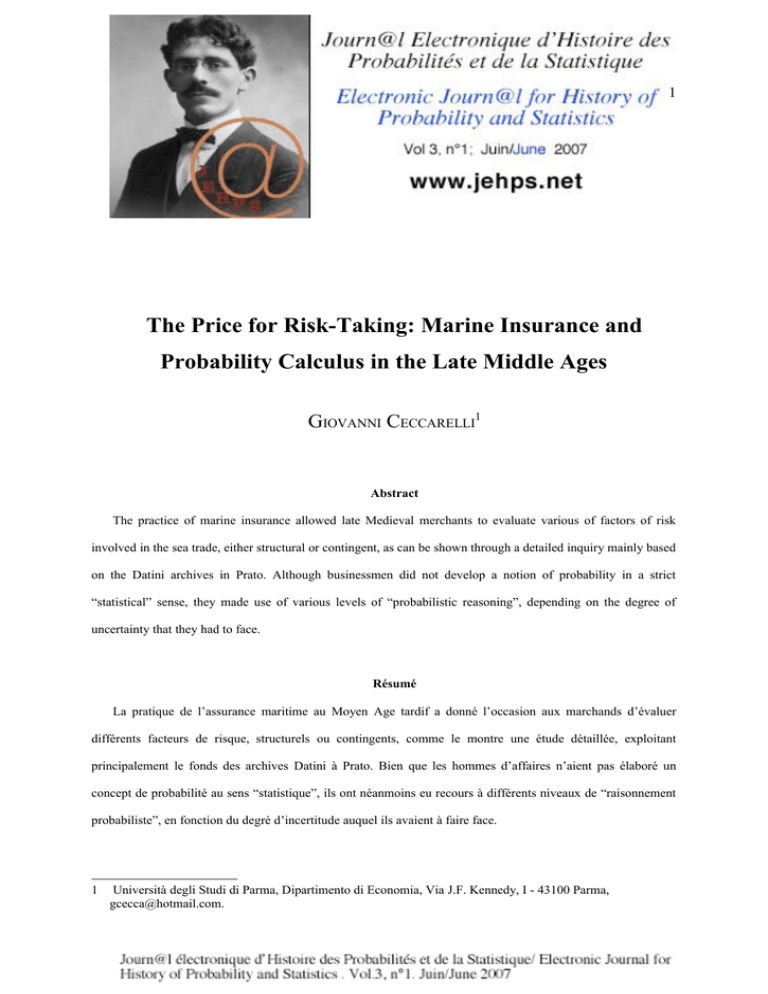
1 The Price for Risk-Taking: Marine Insurance and Probability Calculus in the Late Middle Ages GIOVANNI CECCARELLI1 Abstract The practice of marine insurance allowed late Medieval merchants to evaluate various of factors of risk involved in the sea trade, either structural or contingent, as can be shown through a detailed inquiry mainly based on the Datini archives in Prato. Although businessmen did not develop a notion of probability in a strict “statistical” sense, they made use of various levels of “probabilistic reasoning”, depending on the degree of uncertainty that they had to face. Résumé La pratique de l’assurance maritime au Moyen Age tardif a donné l’occasion aux marchands d’évaluer différents facteurs de risque, structurels ou contingents, comme le montre une étude détaillée, exploitant principalement le fonds des archives Datini à Prato. Bien que les hommes d’affaires n’aient pas élaboré un concept de probabilité au sens “statistique”, ils ont néanmoins eu recours à différents niveaux de “raisonnement probabiliste”, en fonction du degré d’incertitude auquel ils avaient à faire face. 1 Università degli Studi di Parma, Dipartimento di Economia, Via J.F. Kennedy, I - 43100 Parma, gcecca@hotmail.com. 2 It is a quite widespread opinion among economic historians that, during the late Middle Ages, businessmen developed on practical grounds systems to face and evaluate the risks connected with commercial activity.2 A similar statement can be underwritten for the most part, yet some scholars, uncritically applying it to the history of statistical ideas, have claimed that already in the Fourteenth century merchants involved in the sea trade shared a concept of probability. Douglas C. North, went even further by arguing that late Medieval underwriters were able to «make an actuarial determination of the likelihood of en event». Moreover Ivo Schneider, by comparing commercial aleatory contracts with theological thought on risk, has asserted that the culture of the merchants represented a break with past in the realm of chance. On the contrary, Ian Hacking has claimed that an authentic idea of probability appeared only after the middle of the Seventeenth century, and laid the blame for a delay as such to Scholastic thought.3 Regarding this latter opinion, recent studies have proved that late Medieval Scholasticism did contribute towards the development of the concept of probability, for instance when discussing the relationship between risk and business profit. These debates tended to establish that, although chance was to be considered as an attribute of God’s will, it was morally and legally legitimate to exploit it in an economic way. Whether this idea may be interpreted as a form of “proto-probabilistic” reasoning is a question that still has to be analysed in depth, yet it is clear that such an approach provided a fruitful conceptual environment in this realm.4 As James Franklin has shown, theologians and jurists played a relevant role in the emergence of what he calls“logical probability”, i. e. a non-deductive (and usually non-numerical) estimate of the possibilities that an event occurs in the future. Furthermore, Scholastic thinkers, mainly 2 3 4 Cp. [Edler de Roover 1945] and [Melis 1974]. [North 1990], [Schneider 1981], [Hacking 1975]. See [Ceccarelli 2001] and [Piron 2004]. Cp. also [Coume 1970]. 3 in connection with marine insurance, also hinted at the existence of a «numerical» form of probability founded on statistical verification.5 The present study is not directly concerned with theological thought, but it mainly takes into analysis the ways in which late Medieval merchants evaluated (and managed) the number of factors of risk involved in the sea trade. Although an economic historical perspective will be followed, this work will try to shed light on the concept of probability that was adopted in an evaluation as such. It will be shown that, even though businessmen did manage to build up sophisticated contracts in order to cope with the perils of trading activity, they did not feel the need to develop a notion of risk in a strict “statistical” sense.6 Rather, merchants used different levels of “probabilistic reasoning” depending on the degree of uncertainty that they had to face. In some cases they did adopt a form of “proto-statistical” estimation of risk, based on the rough observation of the frequency of the accidents that occurred in the sea trade (i. e. “factual probability”); in other situations, it is likely that they integrated this kind of prediction with a non-deductive and experience-based approach, since the elements that had to be taken into account were far more composite; whereas in the cases in which future events were highly unpredictable, it appears that they simply relied on an intuitive forecast, transposing it in monetary terms.7 Moreover, it will be seen that businessmen adopted multifaceted commercial strategies in order to reduce and redistribute risk, revealing a clear inclination towards practical solutions in facing the dangers that they had to cope with. 5 6 7 [Franklin 2001], ix-xiii, 258-78, and 328. Ibid., 258-9, and 338. Ibid., 324-5. Franklin defines this level as «subsymbolic probability» and argues that it is still commonly used in «business forecasting», given the fact that in extremely complex economic predictions, it is considered to be reliable as much as the most mathematical models, and the best statistical informations. 4 Risk factors in medieval marine insurances The main object of the present study will be marine insurance. This type of contract has been widely studied, since the emergence of insurance policies in the Fourteenth century represented a significant change in comparison with all the arrangements that merchants had previously used to transfer the risk of sea trade to another party. The basic difference between these agreements, technically defined as “pre-insurance pacts” (sea loan, maritime exchange, unilateral and bilateral partnerships, insurance loan, etc.), and an insurance policy is that in the latter risk becomes the specific object of the settlement.8 In the perspective of the present research this point is crucial, since it reveals that businessmen acknowledged that chance events had a monetary value, and hence that they could be estimated through a percentage, namely the premium. It is also of great relevance for it may be that, by focussing on the economic evaluation of the aleatory element of the contract (i. e. the premium), merchants were stimulated to develop a probabilistic approach. As several works show, it was by observing the incidence of chance in its simplest forms, for instance in the tossing of dice, that a broad idea of probability started to emerge.9 Yet, as it will be seen the estimation of the perils of the sea trade is not at all simple, since various levels of probabilistic reasoning are necessary to establish in numerical terms the real incidence of risk.10 Furthermore, the study of insurance policies is relevant because of the vast success of such contract among business communities. By the first decades of the Sixteenth century marine insurance, in the form of the policy, was well established in the Mediterranean markets and began to be commonly used in the seaports of Northern Europe. It can be estimated that in this period the policies yearly taken out in a major market, such as that of Florence, had 8 [Edler de Roover 1945], 172-187. 9 [David 1962], 32-33; [Ceccarelli 2003], 242-3. 10 See [Franklin 2001], 326. 5 reached the number of 700.11 Given the vast amount of contracts subscribed, a basic knowledge of which were the elements of risk that had an influence on insurance premiums was probably widespread among businessmen. For instance, it is possible to find an extensive list of these factors in a manual for merchants, written shortly after the middle of the Fifteenth century. According to the author, Benedetto Cotrugli, those who wish to underwrite a policy «must recall that it is necessary to gather all the news that come from the sea and to pay special attention to them, to constantly ask for and inquire on pirates and evil people, wars, truces, reprisals and all the thing that may perturbe the sea. They must keep navigation maps on their desk and have a good knowledge of the seaports and the beaches, of the distance from one place to another, and they must take into account the condition of the captains, of the insured merchants, and of the vessels, and they must consider the merchandise, since all these elements are required». This relatively short passage is perhaps the most detailed analysis of the factors that influence the premiums of insurance policies that late Medieval merchants’ culture can provide.12 In order to understand whether some kind of probabilistic reasoning was taken into account by businessmen, it is thus necessary to look at these factors more into depth. This is possible by taking into analysis two specific types of sources, namely commercial letters, and insurance contracts. The former one may provide an indirect evidence of the interest paid by merchants to any information that could effect the rates of the premiums; the latter allows a more accurate study of the impact that each of these elements really had on the evaluation of risk. Among insurance policies, of great interest are those contracts in which an additional clause introduces a change that alters a single factor while all the other elements of risk did 11 Cp. [Ceccarelli 2007], esp. 77. 12 [Cotrugli, 1990], 176, § “On insurance and insurers”. The treatise can be dated around 1458, and the translation is mine. A less extended list can be found in another renowned manual for merchants, dating 1442, cp. [Giovanni da Uzzano, 1967], 119. 6 not vary. The present study will mainly rely on the documents of the Datini company that offers an unparalled collection of commercial letters and insurance contracts for the period going from about 1380 to the first years of the Fifteenth century.13 In very general terms, it is possible to divide the factors listed by Cotrugli in two broad categories: 1) structural ones, i. e. elements that are stable, and thus predictable, over a relatively long period of time; 2) contingent ones, i. e. factors that may change in a very short time (from day to day, or even within hours), rapidly modifying the evaluation of risk, and therefore the rates of insurance premiums. Those are the elements that can be considered as structural: the type of vessel, the reputation of the captain that steers it, the distance of the voyage, the season, and the merchandise that is insured. 1. The vessel and the captain The first structural element is the kind of ship. Scholars agree that there was a major distinction between those vessels that had a mixed propulsion (wind and human power) and were usually armed, namely galleys, and the average sailing ships, that were more difficult to steer since they could only rely on wind power, and that unless exceptional cases were not protected by weapons.14 For instance, in the late Fourteenth century the premium required on the route Venice-Balearic Islands was of 3-4% for a standard sailing ship, but it dropped to 1.5% for a Venitian galley.15 A similar differential can be noted on the itinerary Pisa-Genoa, 13 In the Datini fund more than 126,000 commercial letters, and nearly 400 insurance policies taken out in Pisa, Florence, and Genoa are preserved. For an extensive description of these and all the other documents of this massive collection, see [Melis 1962], 3-42. 14 See [Edler de Roover 1945], 191, [Del Treppo 1972], 440-442. 15 Archivio Storico di Prato, Fondo Datini, n. 1158, “Polizze di assicurazione” (from now on cited AsPo 1158), doc. 122 dated April 5, 1396; it is a single policy insuring a shipment of cinnamon, taffeta and cloths on three Venitian galleys heading for Maiorca. Premiums recorded on the same route but on sailing ships («navi») were: 4% in January, 3.5% in May, 3% in September, and again 3.5% in November; cp. Archivio Storico di Prato, Fondo Datini, n. 1159, “Polizze di assicurazione” (from now on cited AsPo 1159), docs. 67, 71, 72, 74, 77. 7 where the rate for an armed vessel could be of 1.25% compared to that of 3% for a ship. 16 This is the reason why business letters were very meticulous in describing the distinctive feature of every vessel. For instance, in 1395 the correspondent of the Datini firm in Maiorca, in reporting to the main branch in Florence that a shipment is ready to sail heading for Pisa, provided all the aspect that were necessary to draw up a policy: the type of vessel, the steerer and the tonnage.17 Above all, letters were careful in informing whether or not a ship travelled under armed escort. Galleys were considered safe enough that the managers of a merchant firm in most cases took the decision not to insure the shipped merchandise. In very general terms it is possible to state that, although freight charges were higher for armed than for unarmed crafts, insurance rates on the former ones were commonly lower by about one half.18 But, as a contract subscribed in Florence in 1397 shows, underwriters were accustomed to make even more subtle distinctions among vessels, in order to define the proper insurance rate. This policy provided three possibilities in regard to the medium of transportation, a galley («galea»), a small galley («galeotta»), and a brigantine («brigantino»); accordingly, two different premium rates were established: 1% for the galea and galeotta, and 1.5% for the brigantino.19 Closely related to the kind of vessel is the reputation of the person that steers it; in the letters written by merchants a close attention is given to every piece of news that concerns a specific captain. For example, the correspondent of the Datini company in Maiorca informs the headquarters in Florence that Iacopo Capponi has finally purchased the craft that he 16 Cp. AsPo 1158, doc. 117, policy taken out on October 13, 1395 on merchandise shipped on a Genoese galley, with AsPo 1158, doc. 103, contract subscribed on January 27, 1395 on goods shipped on a «nave». 17 Cp. [Nigro 2003], vol. 2, 475. Another very detailed letter, concerning an English ship leaving from Southampton and dated 1392, can be read in [Melis 1975a], 55. 18 [Del Treppo 1972], 441; cp. [Melis 1975a], 61 and [Edler de Roover 1945], 194-5. 19 AsPo 1159, docs. 80, 82 e 87 all taken out in 1397 on the itinerary Motrone (nearby Viareggio)-Genoa. The difference among galley, small galley, brigantine only concerns tonnage, since this latter craft was a small scale version of the first two; cp. [Guiral-Hadziiossif, 1989], 60 and [Tenenti & Tenenti], 62. 8 usually steered on behalf of the former ship-owner.20 It seems that businessmen were aware of feckless or simply unfortuned masters in order to avoid them. For instance, a letter dating 1399 is revealing of how much a bad reputation affected the rates of an insurance contract. The vessel steered by Gianni Rossello was anchored in Sluys, the port of Bruges, waiting to be loaded with goods to be carried to Catalonia, but rumors had it that this master was always seized by pirates. For this reason people doing business in Bruges were unwilling to ship their goods on Rossello’s craft and thus the premium rose to an unusual 14%, whereas standard rates ranged from 5% to 8%.21 It is not by chance then that one of the few events which, since their beginnings, insurance policies did not cover is the theft committed by the captain or his crew, defined in juridical terms as barratry. Damages caused to the shipment by untrustworthy steerers are considered unpredictable to the point that they are not even considered as contingent factors of risk such as privateering or captures during military conflicts. 22 Nevertheless, if one takes into analysis the contracts the picture tends to change, and the role of the master of the ship seem to be less relevant in relation to the premium. A good example is provided by some insurance policies, subscribed in Florence at the end of the Fourteenth century, in which the possibility that the vessel is steered by any captain is envisaged.23 This tendency is confirmed by several contracts in which specific clauses allow to replace one master with another, or in which the same shipment is divided between two or even more vessels, obviously steered by different persons. In all these cases, no element of the policy besides the captain changes, yet the premium always remains the same. 24 For instance, we can 20 [Nigro 2003] 478; letter from Maiorca to Florence (June 26, 1395). 21 Letter from the Orlandini company in Bruges to the Datini company in Barcelona edited in [Melis 1975a], 63. Standard rates on the itinerary Sluys-Catalonia can be derived from the premiums of 5 policies underwritten in Pisa and Florence during the years 1393-98; cp. AsPo 1158, doc. 125, and 1159, docs. 31, 56, 75, 89. 22 Cp. [Edler de Roover, 1945], 189. 23 AsPo 1159, docs. 80, 82, 87, 114. In other contracts no indication is given for the captain and for the shipowner cp. AsPo 1158, doc. 78 and AsPo 1159, docs. 10, 11. 24 Examples of both kinds of contracts can be found either in Pisa and Florence. For the first type (i. e. change of vessel and steerer) see AsPo 1158, docs. 110, 130, 132 and AsPo 1159, doc. 102; for the second one (i. e. same policy for two or more shipments) cp. AsPo 1158, docs. 33, 85, 122, 148 and AsPo 1159, docs. 42, 50, 9 recall a contract subscribed in Florence in 1393 and related to a voyage from Valencia or Peñiscola to Genoa. This policy settles that the insured merchandise (Spanish wool) was to be divided and shipped on two different crafts; the first one steered by Francesc Colombiere of Marseille, and the other steered by the Genoese Polo Italiano. Since the premium does not vary, it can be assumed that the two masters were considered of equal reliability and skills.25 Under this light, the idea that the reputation of a captain has a great impact on insurance rates is to be put in its right perspective, since the sources show a twofold framework. On the one side, in standard situations this factor was not considered as a major element of risk evaluation: the changeover of steerers is common and does not lead to a variation of the premium. On the other side, the bad record of a particular master can indeed determine an increase in the insurance rates, but these seem to be very specific and isolated cases. 2. Distance, season, and merchandise The third structural risk-factor that is to be taken into analysis is the distance of the voyage. In general terms, scholars have highlighted that a straight correspondance between the physical length of the trip and the rates of the premiums was not the rule usually followed.26 This trend depended on the fact that the majority of accidents did not occur in deep-sea, but was connected to the dangers of coasts and ports, or to privateering. Thus, underwriters could claim higher premiums for short but risky itineraries and, on the contrary, charge lower rates for long-distance, yet safer, travels. A simple overview of the data provided by late Medieval insurance contracts is in itself revealing. For the late Fourteenth 56, 64. 25 AsPo 1159, doc. 35 (September 30, 1393). 26 See [Del Treppo 1972], 428-433. For the Early Modern Age, see also [Tenenti & Tenenti 1985], 73 and 8283; [Tenenti 1985] esp. 348. 10 century it is possible to compare the rates charged for long-range travels, such as from the Spanish Mediterranean coast to the North sea, with shorter ones like those connecting Tuscany with the ports of Rome (Ostia and «Ripa»). The premiums for the former itinerary (a distance of about 4,000 km) varied between 5.5% and 8%, whereas those fixed for the latter (only 250 Km) normally fluctuated between 8.5% and 12%, with peaks that could reach 14%. This trend is largely to be explained with the intense presence of pirates off the coasts of Southern Tuscany, and of Rome that transformed a short voyage into an extremely dangerous one.27 A similar pattern can be found at the middle of the Fifteenth century. Itineraries that greatly differ in terms of distance, such as those that connect the North Sea either with La Rochelle or the Mediterranean ports (Venice, Pisa, Genoa, Barcelona, etc.), record an insignificant variation in the premiums charged: 10-14% against 8%-14.5%. Once again, it seems that underwriters were aware that the major risks came from a certain area, whereas the rest of the route was in some way irrelevant in the evaluation of the premium.28 A close analysis of the insurance policies allows to underscore how businessmen also paid a particular attention to the perils related to a specific harbour. A contract dating 1393 shows that insurers were very careful in accepting without negotiation that a captain of a vessel could be free to decide among a set of destinations, in this case located on the coast of Provence (Port-deBouc, Aigues-Mortes, or Arles). Among the underwriters, the most cautious ones offer their coverage only if the ship calls at the first two seaports, and obtain to be freed from the risks of an arrival to Arles, that would have entailed the danger of going up the Rhone river.29 27 See AsPo 1158, doc. 125, and AsPo 1159, docs. 31, 56, 75, 89 for the route Catalonia or Balearic IslandsFlanders. For the high premiums recorded on the itinerary Tuscany-Rome by small sailing ships, such as «barche» and «legni» see AsPo 1158, docs. 11, 102 e AsPo 1159, docs. 13, 40, 44 (years 1383, 1391, 1394 and 1395). High rates can be also noted for armed crafts: on June 5, 1399 a «galeotta» was charged with a premium of 11%, cp. AsPo 1159, doc. 135. On the widespread presence of Moor corsairs in the Tuscan archipelago see [Melis 1970], esp. esp. 251-256. 28 These data are taken from [Edler de Roover 1945], 192-3, Table 1: Marine insurance rates in percentage of amount insured according to the account books of the Florentine merchant Bernardo Cambi. 29 Cfr. AsPo 1159, doc. 37. The taking out of these insurers were followed by statements like: «I do not run the risk for Arles and the Rhone» («non corro lo rischio per Arli e lo Rodano»). 11 Concerning another structural factor of risk, namely the season in which the voyage takes place and the overall influence of metereological conditions on the rates of the premiums, scholars have in the past suggested different interpretations. Many of them agree that bad weather had a great impact on the insurance market, but face the question in rather general terms. On the contrary, those few who have engaged in thorough examination on this topic claim that this element, especially for the Fourteenth and Fifteenth centuries, has been overestimated. So, whereas for the Eighteenth century the seasonal variation of the premiums of insurance has been openly proved, for the late Middle Ages a variation as such is still to be clearly measured.30 The sources that up to now have been used in the present study are not conclusive on this point, since in order to establish if and how weather was considered a risk-factor quantitave data are necessary. Nevertheless, some clues on this topic can also be provided by commercial letters and insurance policies. As for the first type of documents, it is noteworthy to notice that merchants, in comparison with other informations, show little interest in metereological conditions. With regards to the second, the real impact of the weather is hard to determine, since there are no insurance policies left in which the only factor that changes is the season. The only contract that may offer some indications is a rather particular one: a “subscription policy” dating 1391 that covered all the shipments of the Datini company on the itinerary Genoa-Pisa, charging a flat rate of 2%. This fixed premium could be interpreted as a proof of the little incidence played by metereological conditions on insurance costs, especially on short itineraries; but on the contrary, it could also be interpreted as an average worked out comparing the standard rates of the winter with those of the summer.31 30 Cp. [Del Treppo 1972], with [Spooner 1983], 200-246. 31 [Daveggia 1963]. See also [Melis 1975a], 28 and 206-7. 12 Moving to more reliable datas, it is possible to state that, in the late Middle Ages, seasonal differences as a whole were not considered as a major element in risk evaluation. The study by del Treppo of over 1,500 insurance contracts signed in Barcelona during the Fifteenth century, shows that the weather affected premiums only on certain routes, and that the increase in the winter rates is never higher than 13%. For instance, on the itinerary that connects Catalonia to the harbours of Provence, the growth of the premiums is of about 5%. On the contrary, the route from Barcelona to the Levant (Alexandria, Rhodes, Syria, Constantinople, etc.) records on average higher rates in the summer than during the bad season. The reason for this selective trend reveals a rational approach to risk, for it is linked to the fact that the worsening of climatic conditions affects only some areas of the Mediterranean, like the Gulf of Lion or the Upper and Medium Tyrrhenian Sea. 32 Nevertheless one must not overestimate this point since merchants, rather than adopting a strategy centered on insurance and probability, made use of more practical techniques to reduce the impact of bad weather. The basic one was to rely on cabotage and coastal navigation, widely preferred in the winter and in the most dangerous routes, instead of facing the perils of the open seas by transporting their goods on vessels of greater size.33 The last structural risk-factor that can be taken into account is the type of merchandise that is insured. Undoubtedly some kind of goods had a higher chance of getting damaged than others during the shipping. The major problem was that of water and damp and affected several products, such as paper, sugar, spices, rice, grains, silk, wool, etc; another type of risk involved liquids, like oil and wine, that had to be transported in containers that were in danger 32 See [Del Treppo 1972], 433-440. 33 Evidences provided by the insurance policies of the Datini company show that on the Upper Tyrrhenian itinerary connecting Genoa and Savona to Pisa cabotage crafts were predominat: only 5 contracts over a total of 47 concern large size vessels («nave»), whereas the vast majority refers to small ones («saetta», «liuto», «vacchetta»). In the mid Fifteenth century, a similar pattern can be found on the itinerary CataloniaProvence, cp. [Del Treppo 1972], 411-412. 13 of breaking or, for the same reason, pottery and glass objects. 34 Commercial letters are very accurate in specifying the goods that are loaded on a ship, especially when the insurance contract is subscribed in a different market from that where the shipping takes places or when an unexpected event occurs. For instance, the correspondent of the Datini company in Maiorca supplies to the main branch of Florence an extensive report of the goods that, for technical problems, were transferred from the cog of Montalari to the ship of Felice del Pace.35 Even insurance policies shows the close attention that underwriters devote to the exact description of the shipped merchandise. A contract underwritten in Florence in 1396 reveals that insurers were accustomed to claim for details about the goods if the initial draft of the policy was too broad on this point. In this case, the underwriter’s refusal to sign the deal until the Datini company acquired the requested informations from his correspondent in Maiorca, lead to a delay of over a month.36 But notwithstanding the high degree of accuracy testified by these cases, it is almost impossible to measure how much the distinctive feature of each product influenced the rates of the premium. Some indications may come from a policy subscribed in Pisa in 1389, in which each underwriter agreed to take the risk only on a specific good: a first one, on two bales of cloth having in exchange a premium of 3.26%, whereas a second one, on nine bails of leather at a rate of 3%. It seems thus, that the differential of 0.26% represented the higher probability that toile had of getting damaged. Yet there is a third underwriter that completely changes the picture, since he concurs in insuring the bails of leather, obtaining a premium of 34 For some examples of damp merchandise («bagnatura») see AsPo 1158, doc. 13. and AsPo 1159, doc. 99, concerning wool and «grana» (a red dyestuff). An increase in the insurance rates probably determined by the good transported (namely, paper) seems to emerge by comparing three policies taken out in the same days (January 13, 18, and 20, 1383), on the same craft (a ship steered by Piero Figliolino), and for the same route (from Pisa to Port-de-Bouc, a seaport near Marseilles). The premium of the policy that covers the shipment of paper reaches 5%, whereas the two others are fixed only at 3%; cp. AsPo 1159, docs. 5, 6, and 7. 35 [Nigro 2003], vol. 2, 470-1. 36 Cp. AsPo 1159, doc. 72; the insurance covers a transport 175 bundles of leather from Maiorca to Venice. 14 5%. Unfortunately, only the first insurer indicated the date in which he signed the contract and thus it is impossible to investigate on what caused such a variation.37 Whatever was the element that induced the change of rate, other similar contracts do not establish a clear relation between the insured item and the rate of the premium.38 Given the difficulty in isolating this factor of risk from all the other ones, it is complicated to measure the impact of a merchandise on insurance costs. It is likely that even insured merchants and underwriters did not have the instruments to evaluate in economic terms the potential of getting spoiled peculiar to certain goods. That is probably the reason why it was rather common among insurers to follow a “non statistical” approach, claiming the exemption from insurance coverage for those goods that were highly subjected to damages. This “exemption strategy”, recalls the one commonly followed in regards of barratry of the captain or his crew. It is possible to find a number of clauses related to the smashing of pottery, the dampening of cloths and rice, or the breaking of the containers in which wine is shipped. In some cases insurers are freed only from the damages that may occur in the most dangerous moments of the transport; for instance a Florentine policy dating 1399 exempts the underwriters from the risks connected only to the unloading of 64 jars of oil.39 3. Pirates, or the «danger factor» As it has been previously said, the existing sources show that in the late Middle Ages a relevant part of the perils related to commerce by sea did not come from structural factors of risk, but rather from contingent ones, such as privateering and the state of war or of peace. An 37 AsPo 1158, doc. 68. 38 In a series of policies dating 1395 concerning a voyage from Pisa to Barcelona no distinction is made among pepper, taffeta, cinnamon, and cloves, cp. AsPo 1158, docs. 96, 97, and 98. 39 See [Del Treppo 1972], 417-418; cp. also AsPo 1159, doc. 112. 15 analysis of the insurance claims recorded in the market of Barcelona during the Fifteenth century clearly supports this thesis. Over a total of 42 reported accidents, shipwrecks were only 12 and, furthermore, many of them did not occur on the open sea but on rocks and shallows near the coasts or even inside the ports during difficult landing operations. On the contrary, the majority of claims was related to the attacks of pirates or hostile warships and to the detainment or seizure by princes or cities at which the vessel called.40 Given the relevance of contingent elements of risk, it is small wonder that commercial letters provide a massive amount of news concernig privateering, naval military manoeuvres, and political frictions between marine powers. In 1394 Nofri Bonaccorsi from Maiorca informs the Barcelona branch of the Datini company that a French corsair, after having captured and robbed a merchant ship heading for Flanders, is moving in the direction of the Levant route. The following year a series of letters from Maiorca, this time sent to the main branch of Florence, provides an extensive picture of the state of uncertainty caused by Moor and Genoese corsairs operating in that part of the Mediterranean. The situation almost turns into a state of war when the Catalan fleet starts to pursue the pirates, and the letters reveal the concern of the Datini correspondent for an indiscriminated reprisal against merchant ships.41 But some areas were in a constant state of military friction, namely the North Sea in which the conflicts between France and England were frequent, increasing the risks of marine trade. Therefore commercial letters constantly updated the situation by giving news on any sign of naval manoeuvres. For instance, in 1403 the London branch of the Orlandini company informed the Datini headquarters in Florence that a fleet based in Southampton was ready to 40 Cp. [Del Treppo 1972], 416-423. A similar picture is provided by the accidents recorded in the insurance policies of the Datini company; out of a total of 10 accidents, only 2 are connected to a shipwreck, whereas 4 are caused by seizures and reprisals by enemy ships or local port authorities: cp. AsPo 1158, docs. 1, 14, 127, 145, 1159, docs. 80, 84, 86. 41 Examples of informations on privateering provided by commercial letters can be found in [Melis 1975a], 568; [Nigro 2003], vol. 1, 15 and vol. 2, 470-4. 16 make to the sea, and thus suggested particular care in insuring shipments that were headed to this part of the Altlantic.42 It is not easy to evaluate the impact of these contingent factors on the rates of the premiums. In very broad terms, it is possible to state that at least 50% of the insurance costs cover the risks connected to privateering and war: usually the premium charged for a transport on a disarmed vessel was twice as much as the sum paid for a safer shipment on a galley. For instance, the rates recorded between 1470 and 1473 on the itinerary that connected the ports of the Upper Tyrrhenian Sea with those of the North Sea are: 4-6% for galleys; 7-12% for ships and whalers.43 Besides this standard differential clearly related to the insurance coverage of what has been defined by del Treppo as the unpredictable “danger factor”, the sources suggest a close relation between contingent risk-factors and premiums. In the late Middle Ages, considerable short-term fluctuations in insurance rates can be noticed on various markets. For instance, in Barcelona the rates recorded for a transport from the Catalan city to Messina between june and july 1461 were the following: 3.5% on june 26, 10-12% on july 1, 4% on july 10. Minor daily fluctuations were also common; the premiums charged on june 3, 1447 in the same contract show a “schizoid” sequence: 6%, 5.47%, and 8%. This trend, as well as the former, can only be explained by the overlapping of rumours about the safety of the sea, since all the structural factors of risk (vessel, steerer, route, and goods) did not change.44 Similar examples can be provided for Pisa: in 1387 the premiums charged for an itinerary intensely affected by privateering (Pisa-Messina) grows, during the same day, from the initial 3% up to 3.5%.45 42 43 44 45 The letter is partially edited in [Melis 1975a], 58. See [Del Treppo 1972], 441; [Edler de Roover, 1945], 192-193, Table 1. [Del Treppo 1972] 440. AsPo 1158, doc. 64. Another case is that of a policy dating 1400, in which a premium of 4% is renegotiated after two days and increased to 5%; cp. AsPo 1158, doc. 147. 17 One can only imagine situations as such, in which the market was shocked by the diffusion of bad news, like the capture of a ship or the breaking out of a conflict, and the normal equilibrium between supply and demand of underwriters is altered by a rapid change in the perception of risk. Yet, in some fortunate cases it is possible to measure the direct impact of the “danger factor” on insurance costs. In 1473 an almost unpredictable event shakes the certitudes of the Florentine insurers: the news that one of the two Burgundian galleys, the “Saint Matthew”, was captured in the North Sea by caravel of the privateer Paul Beneke. The two armed vessels were expected to deliver in Pisa the merchandise loaded in Zeeland, and the premium was set at the rather low rate of 4%. The second galley manages to take refuge in Southampton, where it is loaded up with other items to carried to Tuscany; three months later, a new policy is then subscribed in order to insure this shipment, but the increased perception of risk leads to a growth of 50% in the rates charged and the premium is fixed at 6%.46 A rather moderate increase as such may be considered as a proof of an approach to privateering risks grounded on some kind of probabilistic reasoning: perhaps the insurers thought that Beneke felt satisfied by the seizure of the “Saint Matthew”. Yet it is not fully clear what was the type of probability that underwriters referred to: it could have been a rough form of statistical evaluation, but also an expectation founded on logical reasoning and experience, or even a simple form of subjective prediction regarding the likelihood of a second capture. In a situation as such it is difficult to draw a sharp line among these three forms of forecasting.47 In other cases the strategy followed by insurers seems to be more plain. In 1385 a Florentine firm refused to insure any vessel leaving from Famagosta, since commercial letters reported that the seas around Cyprus were infested by corsair ships. Anyhow, after many 46 [Edler de Roover 1945], 191-194. 47 Cp. [Franklin 2001], 324-6. 18 pressures the firm accepted to take on a policy in favour of the shipment of the Venitian merchant Benedetto Bon, evaluating the risks at the exceedingly high premium of 85%. 48 Can this rate be considered as the consequence of an estimation based on an factual or logical kind of probability, or rather as a sort of a “symbolic” numerical transposition of the extremely uncertain condition? As it can be seen in other situations in which the “danger factor” is intense to the point that it tends to prevent from any sharp estimate of the risk, the second interpretation is more likely. Whenever contingent factors appeared to be overwhelming, the response of the market was to charge premiums that seem to reflect an intuitive form of prevision: 50% for a vessel that rumors had it that to be sunk, in London in 1464; 75% for a ship that everyone thought was lost in Barcelona in 1384.49 In other words, under conditions of extreme unpredictability insurance policies tended to change into contracts that were more akin to a bet.50 Yet, to adopt a strategy founded on subjective forecasting in order to cope with an extreme level of uncertainty can be considered as a rational economic option. On the contrary, it would have appeared to be irrational that businessmen, in default of any reliable data, had insisted on following a statistical approach to determine the premiums. It is noteworthy to underline that, although contingent elements heavily affected the evaluation of insurance costs, businessmen do not seem to adopt the strategy of excluding this type of danger by introducing additional clauses, as they commonly did for barratary and goods highly subjected to damages. The examples that can be cited are very rare and concern the Sixteenth century, as in the case of a contract in which a French ship travelling from Bordeaux to London is insured, but the underwriters are not liable if the vessel is captured by 48 [Melis, 1974], 234. Needles to say that as soon as the ship reached the high seas it was attacked, burned and robbed by the pirates. 49 It should be recalled that, although the late Middle Ages underwent a process of quantification of reality and economic evaluation played a major role in this process, a symbolic function of money and numbers has undoubtedly persisted. Cp. the mainstream approach in [Crosby, 1997], 199-223 with the more problematised one in [Kaye 1998]. See also [Travaini 2003]. 50 Cp. [Melis, 1975a], 64; [Piattoli 1940], esp. 169. On this point see also [Franklin 2001], 278. 19 the Spanish or the English fleets.51 It seems that late Medieval insurers knew that the coverage from privateering and other types of seizure was an essential part of the contract and, therefore, that to exclude such risks would have seriously damaged the insurance market as a whole. Rather, merchants adopted other strategies in order to reduce this type of contingent risk. For instance, when the presence of pirates was reported, it was a common practice not to sail in the high seas but to hug the coast, or not to navigate alone but to move in convoy.52 Conclusion : a practical and experience-based response to risk It has been claimed that late Medieval businessmen did not need «elaborated statistical information» in order «to measure the risk with a fair degree of accuracy», and thus to determine an insurance rate that broadly corresponded to the chances of incurring in a loss. As it has been previously said, this statement can be underwritten for the most part, given that insured merchants and underwriters in estimating the premiums took several elements into account.53 In order to cope with the dangers connected with their activity, businessmen could count on a well established experience developed in years of deals, increased by the study of manuals such as that of Cotrugli, and handed down from one generation to another.54 Moreover, these elements of evaluation were constantly updated with the stream of news reported by correspondents of firms spread around the major European seaports, a relatively fast stream in comparison with the slow rythms of the sea trade of that time.55 But, to what 51 [Melis, 1975a], 161. 52 Several examples taken from commercial letters are provided by Melis, Origini e sviluppi delle assicurazioni, 56-7. Cp. also Federigo Melis 1975b], esp. 88-94 . 53 [Edler de Roover 1945] 180. 54 On the experience developed by late Medieval merchants see, for example, the essays collected in [Lane &. Riemersma 1952], esp. 41-101. 55 For instance, a letter from Maiorca on average arrived to Florence after only 22 days. A comparison with the simple crossing from the Balearic seaport to Pisa (frequently only 3 days) could be misleading, for many factors tended to lengthen the time needed to ship a merchandise. For instance, the loading of all the goods that could be transported on a vessel could require weeks, since ship-owners and merchants favoured low 20 extent commercial skills combined with an updated information allowed merchants to manage the elements of uncertainty that were related to each shipment? Do the sources that have been taken into analysis reveal that late Medieval businessmen systematically applied to insurance a probabilistic reasoning founded on «actuarial» evidence? As the many examples given show, an attempt to employ a form of risk evaluation as such is clearly visible just for those factors that did not change rapidly. And, even among structural factors of risk, only the type of vessel has a significant impact on the rates of the premiums, whereas the others (i.e. the captain of the ship, the route, the season of the voyage, and the merchandise insured) seem to affect them in a rather complex way. Furthermore, it has been seen that insured merchants and underwriters had mainly to deal with contingent factors of risk. Privateering and seizures caused by a state of war, which counted for at least 50% of the insurance costs, were very hard to foresee and produced bubbles on the markets. Since the “danger factor” was largely prevailing in the insurance sector, it is doubtful that businessmen were in the ideal condition to develop a notion of probability founded on statistical verification. Rather, they had to complement their estimate with subjective experience-based reasoning and, more likely, to rely on intuitive forms of prevision.56 Under this light, the strategy followed by merchants in order to reduce and redistribute the perils of sea trade appears to be a practical response to a context in which a sharp forecast of future events was extremely difficult. In a strategy as such, insurance did have a role, but it was often combined with several other tools which allowed a better coverage from risks. freight costs to travel speed. In some cases, long waitings were caused by bad weather or the reported presence of privateer, in others the chartered vessel by a businessmen could have a great delay in calling the port were it was expected in order to ship the merchandise. Therefore, as Ugo Tucci says, it was common for ships to be in dock for weeks and even months. Cp. [Melis 1973], esp. 201 with [Melis 1961], esp. 115 and [Tucci 1985], esp. 374. Complaints about ships that delayed or did not arrive in the expected time can be frequently found in commercial letters, see for example [Nigro 2003], vol. 2, p. 448. 56 Perhaps it is not a case that statistical methods were to be applied to marine insurance only after the endemic state of uncertainty caused by piracy started to decline in the Eighteenth century; cp., for instance, [Spooner 1983], 167. 21 Some of these tools were deeply tested in centuries of business experience and were commonly adopted long before the appearance of insurance policies: 1) the use of partnership contracts in which the capital is divided among a number of investors; 2) the habit of shipping small amounts of goods on many vessels; 3) the alternate choice of either cabotage or high sea sailing, depending on weather conditions and the presence of pirates; 4) the practice of moving in convoy in order to put up a better resistance in case of attack. 57 Other techniques were developped to reduce the risk taken by underwriters: 1) the widespread use of coinsurance among many persons; 2) the habit of reassuring the amount covered by an insurer to a third party; 3) the exemption from specific types of dangers granted by an additional clause inserted in the policy; 4) the appearance of small and temporary partnerships among insurers.58 Many other examples could be added to these short lists, anyhow the point that has to be underlined is that businessmen could rely on a wide range of multi-faceted instruments that allowed a flexible strategy of risk diversification. In this perspective, it is clear that the main concern of the late Medieval merchant was not to have «elaborated statistical information», but to count on tools that could effectively reduce the dangers connected with trade activity. In order to do so probability in an actuarial sense, based on the strict observation of the frequency of the accidents, was not so important. It was nevertheless indispensable to overcome the long-established idea that chance was an attribute of God’s will, and that thus it was not exploitable on economic grounds.59 A “protoprobabilistic” background as such served as the basis for the recognition that aleatory factors affecting the sea trade could be represented in monetary (and thus numerical) terms. Although businessmen began to get accustomed to it by the use of “pre-insurance pacts”, this way of 57 Cp.[De Roover 1965], esp. 70-105. 58 Examples of the common use of these tecniques are provided by [Melis 1975a], 12-13, 87, and 93; for partnerships among insurers in late Medieval Florence see [Ceccarelli 2007], 74. 59 Traces of this attitude can be found even in Francesco di Marco Datini, a merchant accustomed to rely on insurance policies. Datini harshly picks up his correspondent in Genoa for not having insured a shipment, sarcastically asking him whether he thought to be a «fortune-teller»; cited in [Origo 1997], 179-80. 22 reasoning was strongly favoured by the spread of insurance policies. It must be indeed acknowledged that merchants were able to detect a stable and in some way measurable relation between profit and chance, by noticing the influence of the structural factors of risk on insurance rates. Yet, an acknowledgment as such cannot be considered as a conclusive proof for arguing that a probabilistic reasoning based on statistical observation was commonly applied. As the sources taken into analysis show, the impact of this approach was limited by the constant use of other types of a probabilistic reasoning. Approximation based on intuitive grounds, available information, and experience in commerce was a suitable and perhaps more flexible element of evaluation. An indirect support to this thesis is provided by what, right in the same years, Scholastic thought has stated in discussing on insurance and other aleatory contracts. Several jurists and theologians tended to reveal a vision of probability that was very akin to that of late Medieval businessmen, by developing the notion of «equal exposition to risk» (par periculi causa). This notion does not only show that an economic exploitation of chance events was considered morally licit, but also that Scholastic thinkers were in search for the proper criterion to measure risk in numerical terms.60 Nevertheless, given the complexity of the factors that had to be taken into account, the discussion devoted to insurance costs ends up to be extremely vague. Regarding this point, it is noteworthy to recall what the Franciscan friar John of Prato writes at the middle of the Fifteenth century. After stating that the premium has to comply with a correct proportion between the risks suffered and the money earned by the underwriter, the theologian ends up to rely on those businessmen who are experienced in the insurance sector in order to verify whether the principle of par periculi causa is fulfilled or not.61 60 See [Ceccarelli 2003], 238-55. 61 Ioannis de Prato, Contractus, Padua, Biblioteca Universitaria, ms. 694, fol. 145r. For a transcription of this text see [Ceccarelli 2006], esp. 1195. Under this light I tend to disagree with those who state that Scholastic thinkers, when discussing insurances, hinted at the existence of a «numerical probability»; cp. [Franklin 2001], 328. 23 John of Prato’s words catch all the difficulties that merchants and scholastic thinkers who discussed about their business had in dealing with the dangers of the sea trade. They also show that in the late Middle Ages, even though in connection with insurance some kind of probabilistic reasoning was developed, the basic concern was a practical and experiencebased response to risk. In this perspective, businessmen and theologians hinted at some of the features that form the vast realm of probability, but these elements would be fully identified only in the following centuries. 24 Bibliography Sources [Cotrugli, 1990] Benedetto Cotrugli, Il Libro dell’arte di mercatura, ed. U. Tucci, Venice, Arsenale editrice, 1990. [Giovanni da Uzzano, 1967] Giovanni da Uzzano, La pratica della mercatura, in Giovanni Francesco Pagnini, Della Decima e di varie altre gravezze imposte dal comune di Firenze, della moneta e della mercatura de’ Fiorentini fino al secolo XVI, vol. 2, Bologna, Forni, 1967, reprint of a 1765-66 edition. Studies [Ceccarelli, 2001] G. Ceccarelli, « Risky Business. Theological and Canonical Thought on Insurance from the Thirteenth to the Seventeenth Century », The Journal of Medieval and Early Modern Studies, 31/3, 2001, p. 602-652. [Ceccarelli, 2003] G. Ceccarelli, Il gioco e il peccato. Economia e rischio nel Tardo Medioevo, Bologna, il Mulino, 2003. [Ceccarelli, 2006] G. Ceccarelli, « Quando rischiare è lecito. Il credito finalizzato al commercio marittimo nella riflessione scolastica tardomedievale », in Ricchezza del mare. Ricchezza dal mare. Secc. XIII-XVIII, Atti della “Trentasettesima Settimana di Studi” (11-15 aprile 2005) dell’Istituto internazionale di Storia economica F. Datini di Prato, ed. S. Cavaciocchi, Florence, Le Monnier, 2006, p. 1187-1199. [Ceccarelli, 2007] G. Ceccarelli, « Cittadini e forestieri nel mercato assicurativo di Firenze (secc. XIV-XVI) », in Identità civica e comportamenti socio-economici tra Medioevo ed Età moderna, ed. P. Prodi et al., Bologna, CLUEB, 2007, p. 73-102. [Coumet, 1970] E. Coumet, « La théorie du hasard est-elle née par hasard? », Annales: Economies, sociétés, civilisations, 25, 1970, p 574-598. [Crosby, 1997] A. W. Crosby, The Measure of Reality. Quantification and Western Society. 1250-1600, Cambridge, Cambridge University Press, 1997. [Daveggia, 1963] Claudio Daveggia, « Una nuova forma assicurativa medievale: la polizza in abbonamento nell’assicurazione », Diritto e pratica nell’assicurazione (Rome), 5, 1963, p. 228-238. [David, 1962] F. N. David, Games, Gods and Gambling. The Origins and History of Probability and Statistical Ideas from the Earliest Times to the Newtonian Era, London, Charles Griffin, 1962. [Del Treppo, 1972] Mario del Treppo, I mercanti catalani e l'espansione della corona d'Aragona nel secolo XV, Naples, L’Arte tipografica, 1972. 25 [De Roover, 1965] R. De Roover, « The Organization of Trade », in Cambridge Economic History of Europe, vol. 3: Economic Organization and Policies in the Middle Ages, ed. Michael M. Postan et al., Cambridge, Cambridge University Press, 1965, p. 42-118. [Edler De Roover, 1945] Florence Edler de Roover, « Early Examples of Marine Insurance », The Journal of Economic History 5-2, 1945, p. 172-200. [Franklin, 2001] J. Franklin, The Science of Conjecture: Evidence and Probability before Pascal, Baltimore-London, The Johns Hopkins University Press, 2001 [Guiral-Hadziiossif, 1989] Jacqueline Guiral-Hadziiossif, Valencia: puerto mediterráneo en el siglo 15: 1410-1525, Valencia: Edicions Alfons el Magnanim, 1989; Spanish transaltion of the original French edition, Paris: Universite de Paris 1-Pantheon-Sorbonne, 1986. [Hacking, 1975] Ian Hacking, The Emergence of Probability. A Philosophical Study of Early Ideas of Probability, Induction and Statistical Inference, Cambridge, Cambridge University Press, 1975. [Kaye, 1998] J. Kaye, Economy and Nature in the Fourteenth Century: Money, Market Exchange, and the Emergence of Scientific Thought, Cambridge, Cambridge University Press, 1998. [Lane & Riemersma, 1952] F. C. Lane and J. C. Riemersma eds., Enterprise and Secular Change: Readings in Economic History, London, Allen Unwin, 1952. [Melis, 1961] F. Melis, “La situazione della marina mercantile all’inizio dell’epoca enrichina: fattori tecnici ed economici di sviluppo,” in I trasporti e le comunicazioni nel Medioevo ed. L. Frangioni, Florence, Le Monnier, 1984, p.111-118 (originally published in 1961). [Melis, 1962] F. Melis, Aspetti della vita economica medievale (Studi nell’Archivio Datini di Prato), vol. 1, Siena, Monte dei Paschi di Siena, 1962. [Melis, 1970] F. Melis, “Movimento di popoli e motivi economici nel Giubileo del 1400,” in I trasporti e le comunicazioni nel Medioevo, p. 237-259 (originally published in 1970). [Melis, 1973] F. Melis, “Intensità e regolarità nella diffusione dell’informazione economica generale nel Mediterraneo e in Occidente alla fine del Medioevo,” in I trasporti e le comunicazioni nel Medioevo, 179-223 (originally published in 1973). [Melis, 1974] F. Melis, « Sulla realtà dell’assicurazione nei trasporti marittimi (secoli XIVXV) », in I trasporti e le comunicazioni nel Medioevo, p. 225-235 (originally published in 1974). [Melis, 1975a] F. Melis, Origini e sviluppi delle assicurazioni in Italia (secoli XIV-XVI), vol. 1, Le fonti, ed. B. Dini, Roma, Istituto Nazionale delle Assicurazioni, 1975. 26 [Melis, 1975b] F. Melis, « Sulla nazionalità del commercio marittimo InghilterraMediterraneo, negli anni attorno al 1400 », in I trasporti e le comunicazioni nel Medioevo, 81101, esp. 88-94 (originally published in 1975) [Nigro, 2003] G. Nigro, Mercanti in Maiorca. Il Carteggio datiniano dall’isola (1387-1396), Florence, Le Monnier, 2003. [North, 1990] D. C. North, Institutions, Institutional Change, and Economic Performance, Cambridge, Cambridge University Press, 1990. 4 [Origo, 1997] I. Origo, Il mercante di Prato (Milan: Rizzoli, 1997 ), Italian translation of The Merchant of Prato, London, Jonathan Cape, 1957. [Piattoli, 1940] L. Piattoli, « Ricerche intorno all’assicurazione nel medioevo VI: Due liti assicurative tra Italiani in Londra del 1464-65 », Assicurazioni, 7, 1940, p. 165-176. [Piron, 2004] S. Piron, « L’apparition du resicum en Méditerranée Occidental, XIIe-XIIIe siècles,” in Pour une histoire culturelle du risque. Genèse, évolution, actualité du concept dans les sociétés occidentales, under the direction of E. Collas-Heddeland et al., Strasbourg, Editions Histoire et Anthropologie, 2004, p. 59-76. [Schneider, 1981] I. Schneider, « Why Do We Find the Origin of a Calculus of Probabilities in the Seventeenth Centuries? », in Probabilistic Thinking, Thermodynamics, and the Interaction of the History of Philosophy of Science: Proceedings of the 1978 Pisa conference on the history and philosophy of science, ed. J. Jintikka et al., Dordrecht, Reidel, 1981. [Spooner, 1983] F. C. Spooner, Risk at Sea: Amsterdam Insurance and Maritime Europe, 1776-1780, Cambridge: Cambridge University Press, 1983. [Tenenti, 1985] A. Tenenti, « Componenti ed evoluzione dei tassi assicurativi mediterranei nel secolo XVI », in Contributi del convegno di studi: Aspetti della vita economica medievale, (Firenze-Pisa-Prato), 10-14 marzo 1984, Florence, E. Ariani and L’arte della stampa, 1985. [Tenenti & Tenenti, 1985] A. Tenenti and B. Tenenti, Il prezzo del rischio. L’assicurazione mediterranea vista da Ragusa: 1563-1591, Rome, Jouvence, 1985. [Travaini, 2003] Lucia Travaini, Monete, mercanti e matematica: le monete medievali nei trattati di aritmetica e nei libri di mercatura, Rome, Jouvence 2003. [Tucci, 1985] U. Tucci, « I trasporti terrestri e marittimi nell’Italia dei secoli XIV e XV », in Contributi del convegno di studi: «Aspetti della vita economica medievale» (Firenze-PisaPrato), 10-14 marzo 1984, Florence: E. Ariani and L’arte della stampa, 1985.
